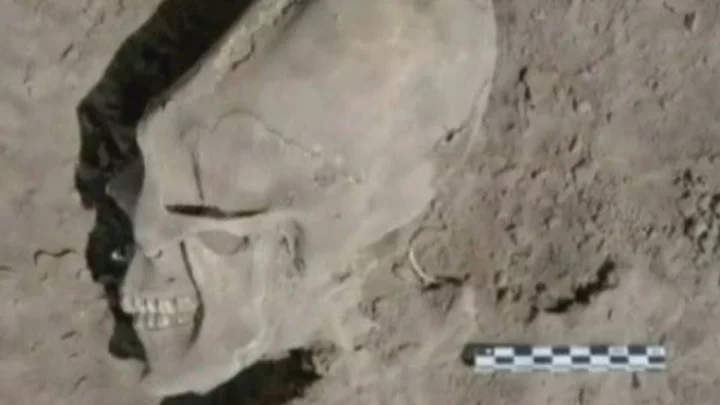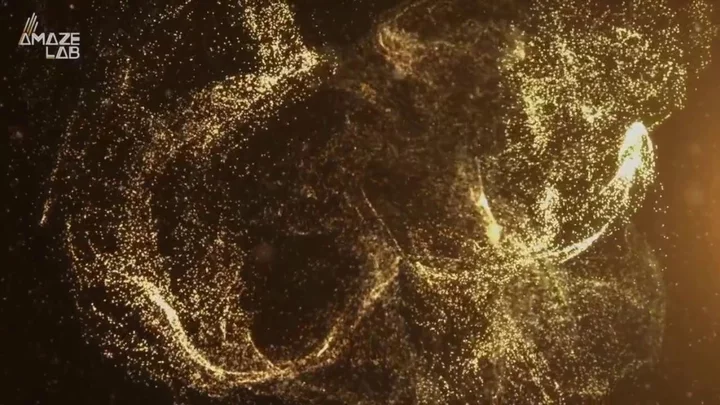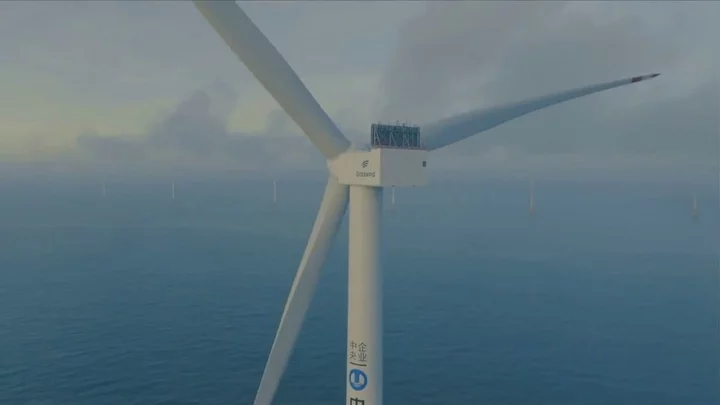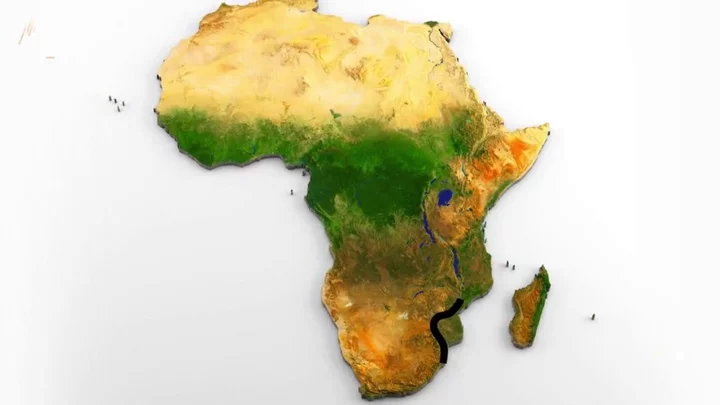
Scientists discover skull that has never been seen before
Scientists have discovered an ancient skull in China, like no other they've seen before. The 300,000-year-old child skull was first discovered in Hualongdong back in 2019 alongside other fossil remains. The Chinese Academy of Sciences (CAS) have struggled to match them to a known lineage. The discovery left researchers baffled as it did not resemble Neanderthals or Denisovans, according to Science Alert. It led them to believe we are either missing a branch from the human family tree or need to add to it. While the skull had similarities to early modern humans, there is a lack of chin and was likened to an extinct species of human in Asia known as a Denisovan. This shape has "never been recorded in late Middle Pleistocene hominin fossil assemblages in East Asia," scientists said in a recent analysis. They believe the remains, known in the science world as HDL 6, could possibly be a combination of modern human and unknown hominin that existed in China, according to the outlet. Sign up for our free Indy100 weekly newsletter In other scientific news, archaeologists are too afraid to open the tomb of Qin Shu Huang, who ruled from 221 BC to 210 BC. The tomb is guarded by a terracotta army of soldiers and horses and was found by farmers back in 1974 in the Shaanxi province of China. Not only do archaeologists believe it will cause damage, but there are rumours of deathly booby traps that could kill curious intruders, according to IFL Science. Writings by Chinese historian Sima Qian 100 years after Qin Shu Huang's death claim "Palaces and scenic towers for a hundred officials were constructed and the tomb was filled with rare artifacts and wonderful treasure." He continued: "Craftsmen were ordered to make crossbows and arrows primed to shoot at anyone who enters the tomb. Mercury was used to simulate the hundred rivers, the Yangtze and Yellow River, and the great sea, and set to flow mechanically." Have your say in our news democracy. Click the upvote icon at the top of the page to help raise this article through the indy100 rankings.
2023-08-08 00:29

Scientists are embarking on a desperate hunt to find the source of dark matter
Scientists are trying to work out the source of dark matter. A group want to house a giant international particle detector that would be built 3,000ft underground in a working mine in Boulby, North Yorkshire to find the cause of the mysterious space matter. “We are entering the last-chance saloon to show that these particles are the cause of dark matter, and we want to make sure Britain is at the heart of that work by building the final generation of these detectors,” physicist Professor Chamkaur Ghag of University College London told the Observer. Scientists know the universe contains more matter than can be seen directly because they can see galaxies held together in clusters when they should be flying apart. Extra mass must be generating more gravity and holding these galaxies together, Most researchers think particles called weakly interacting massive particles – Wimps - are the source of dark matter. But these Wimps are hard to detect so scientists are trying to have a proper stab at it by combining resources and working in one Yorkshire site. “And what we are striving to do in Britain is to get it built at Boulby. Essentially, we want the last-chance saloon for Wimps to be built in the UK,” said Ghag. Dark matter accounts for around 85 per cent of the universe’s mass.There are also mines in South Dakota, and near Rome in Italy that are also hunting for Wimps which could provide answers. Have your say in our news democracy. Click the upvote icon at the top of the page to help raise this article through the indy100 rankings.
2023-08-06 19:25

Here's how your sex toy could be damaging your internal organs
Sex toys may seem harmless, but many have not been assessed for health risks and could have terrible effects. According to experts, our body may absorb the chemicals in the toys and recent experiments at Duke University found that four different sex toys, including anal toys, beads, dual vibrators, and external vibrators, shed nanoplastic fragments when mechanically rubbed and scraped. What's more, all these sex toys were found to contain phthalates; a group of chemicals that that can damage the liver, kidneys, lungs, and the reproductive system, at high enough concentrations. More research needs to be done to see if adults can absorb these chemicals when using sex toys on permeable tissues but it doesn't sound great. Sign up to our free Indy100 weekly newsletter Especially as the United Kingdom lacks specific chemical regulations for sex toys. "Some of the phthalates identified in our experiments have been observed concurrently with serious fertility complications or loss of fertility in rodents at high concentrations," the authors of the study wrote, "though causation may not have been demonstrated, the correlation is concerning enough to warrant further investigation." So next time you think about spicing up your life in the bedroom, take care. Have your say in our news democracy. Click the upvote icon at the top of the page to help raise this article through the indy100 rankings.
2023-08-06 15:48

The surprising reason it is bad to suck your stomach in
Self-conscious people may suck in their stomachs - but doing so can be unhealthy. Adam Taylor, Professor and Director of the Clinical Anatomy Learning Centre, Lancaster University, has explained that the habit can create abdominal imbalance and all sorts of problems. In an article, he explained: "This can lead to a condition called 'hourglass syndrome; – a detrimental change in the structure of the abdominal wall, which may cause a visible crease to form in the mid-abdomen. Not only that, but this change can also have a knock-on effect on the internal organs and other parts of the body if left untreated." He added: "When we suck our stomach in it causes our rectus abdominis (commonly referred to as our "six-pack" muscles) to contract. But since we tend to store more fat tissue in our lower abdomen, the muscles at the top of the stomach tend to be more active. This creates a fold or crease in the abdomen over a long period, with the belly button being pulled upwards. "Sucking the stomach in places greater pressure on the lower back and neck. This is because they now have to compensate for changes in core stability." Sign up to our free Indy100 weekly newsletter He also said it may lead to changes in breathing capacity, though said more research needs to be done, and said sucking in the abdomen also puts strain on the pelvic floor which could cause incontinence. Fortunately, hourglass syndrome is reversible through exercises that strengthen core muscles like planks or bridges, he explained. And he also said the condition develops over weeks of consistently sucking in the stomach. "So occasionally sucking the stomach muscles in is not likely to cause problems," he said. Who knew it could have so many bad effects? Have your say in our news democracy. Click the upvote icon at the top of the page to help raise this article through the indy100 rankings.
2023-08-05 18:17

A crispy roast potatoes recipe could be the key to life on Earth
A chemical reaction that gives food flavour could have helped evolution, one study suggests. According to New Scientist, the Maillard reaction is when the temperature between sugars and amino acids rises above approximately 140°C. It often occurs in food such as toasted bread, meats and roasted vegetables. Caroline Peacock at the University of Leeds wanted to explore whether it could happen at lower temperatures. To do this, scientists added iron or manganese minerals to a solution made up of sugar glucose and the amino acid glycine. When the substance was incubated at 10°C, the process was sped up by around 100 times. The temperature is said to be similar to the seabed at the edges of continents. Peacock and the team discovered that the Maillard reaction also occurs on the ocean floor, where iron and manganese minerals are often found. If this is the case, it could cause the carbon in sugars and amino acids to be stored in "large, complex polymers that microbes find harder to ingest," Peacock said, as per the publication. Sign up for our free Indy100 weekly newsletter "If you can get your carbon through the 1-metre danger zone [at the top of the sea floor], where carbon generally is attacked and degraded and turned back into carbon dioxide by microbes, that will lock it away from the atmosphere," she explained. The team estimated that the minerals could lock away roughly 4 million tonnes of carbon every year. If this process didn't exist, the atmosphere could have warmed by a further 5°C over the past 400 million years, the study suggested. "This process has such a profound impact on atmospheric oxygen," she says. "Because complex life forms require higher levels of oxygen, as they’re more energetically demanding, we think it’s reasonable to surmise this process had a hand in creating conditions required for complex life." Have your say in our news democracy. Click the upvote icon at the top of the page to help raise this article through the indy100 rankings.
2023-08-05 00:21

AI spots dangerous asteroid heading towards Earth that scientists missed
So far this year, we’ve mostly been seeing artificial intelligence pop up on our timelines as a tool for creating trivial things like odd news songs from classic bands or bizarrely sexualised images of classic artworks However, it looks like AI had a vital practical implementation recently after spotting a dangerous asteroid heading close to Earth that was originally missed by scientists. A 600-foot asteroid named 2022 GN1 was found thanks to a new algorithm, and it was revealed that our planet had a close shave with the object last year. As it’s now been revealed, 2022 GN1 flew a relatively close 4.5 million miles from Earth in September 2022. Sign up to our free Indy100 weekly newsletter It sounds like a huge distance, but it falls within the definition of a potentially hazardous asteroid (PHA). At the time, it was completely missed due to it being obscured by starlight from objects in the Milky Way. The algorithm, named HelioLinc3D, spotted the object after observing data from the Zwicky Transient Facility (ZTF) telescope. The team leader behind the algorithm, Mario Jurić, released a statement saying: “This is just a small taste of what to expect with the Rubin Observatory in less than two years, when [the algorithm] HelioLinc3D will be discovering an object like this every night. “But more broadly, it’s a preview of the coming era of data-intensive astronomy. From HelioLinc3D to AI-assisted codes, the next decade of discovery will be a story of advancement in algorithms as much as in new, large, telescopes.” Meanwhile, scientists think they have come up with a new approach to mitigating global warming: put up a giant “umbrella” in space to protect the Earth from excess sunlight. Have your say in our news democracy. Click the upvote icon at the top of the page to help raise this article through the indy100 rankings.
2023-08-04 23:28

Man with 'projected age of 200' reveals he would drink alcohol for breakfast
A man who has spent 'millions' trying to biologically lower his age in order to live longer reveals he drinks alcohol every morning for breakfast. Bryan Johnson, 45, has the 'biological age' of an 18-year-old, and is projected to live to be 200. He made the shocking confession on Steven Bartlett's Diary Of A CEO podcast, where he told of how his final meal of the day is done by 11am. Johnson says he loves wine, and would have 3oz with his breakfast before it became too expensive. Sign up to our free Indy100 weekly newsletter
2023-08-03 21:18

A hidden iPhone setting has been discovered that drains your battery
There's nothing worse than the dreaded 10 per cent battery alert kicking in while out and about and no charger at hand. Well now, a hidden iPhone setting that could be draining your battery has been revealed – and most people don't even know it exists. The 'Wi-Fi Assist' setting is a program to monitor your phone's connection. When there's no Wi-Fi, your phone automatically switches to 4G/5G. All the while, it will be working overtime in the background to maintain a connection with the Wi-Fi, despite it being on one bar. "For example, if you're using Safari with a poor Wi-Fi connection and a webpage doesn't load, Wi-Fi Assist will activate and automatically switch to cellular so that the webpage continues to load," the Apple website explains. While this is a great feature for smooth internet browsing, it could very well be draining out the battery life and mobile data. To turn this off, all you need to do is head to Settings > Mobile Data > Wi-Fi Assist and simply switch it off. To really max iPhone battery life, you can also use Low Power Mode, turn down the brightness and limit Location Services, which can be found in Settings > Privacy. Sign up for our free Indy100 weekly newsletter It comes after the news that the iPhone 15 Pro battery life could very set new records. According to reports, there are rumours of two major updates that involve prolonging that much-needed battery. Laptop Mag suggested that Apple users could expect a larger battery, without the need to bulk up the device. In June, Twitter leaker AppleTrack claimed to have information on the capacity of the iPhone 15. Have your say in our news democracy. Click the upvote icon at the top of the page to help raise this article through the indy100 rankings.
2023-08-03 19:23

Mega wind turbine with blades twice the size of a football pitch switched on for first time
In the week that it was announced that Rishi Sunak will be granting new oil and gas licences in the North Sea, new commitments to renewable energy are being made elsewhere in the world. The China Three Gorges Corporation just turned on a mega wind turbine with blades twice the size of a football pitch in the Taiwan Strait. The state-owned energy firm has activated the biggest wind turbine on the planet offshore in a move which could produce up to 16 megawatts of energy, and it’s now been connected and hooked up to the energy grid. The MySE 16-260 turbine stands at an incredible 500ft (152m) tall and it could power thousands of homes every year. Sign up to our free Indy100 weekly newsletter In fact, it’s thought that around 36,000 homes will be served by electricity from the turbine. It’s not surprising given that each blade weighs around 54 tons and covers nearly 540,000 square feet when they rotate. Mingyang Smart Energy is the company that designed the turbine, and they released a message on LinkedIn making clear just how much wind the structure could deal with – stating that it can withstand “extreme wind speeds of 79.8 [meters per second]”. It’s a staggering feat of engineering and it’s thought that the turbine could save around 54,000 tons of carbon dioxide compared to coal power plants. More structures like one are being planned, too. Executive Director Lei Lei Zengjuan told the media: “In the next step, the 16 [megawatt] unit will be applied in batches in the second phase of the Zhangpu Liuao Offshore Wind Farm Project constructed by China Three Gorges Corporation.” It comes a few weeks after work was stopped on one of the UK’s largest offshore wind farms after its developer said that the cost of the project had soared by so much that it no longer made financial sense to push forward. Swedish energy giant Vattenfall, one of Europe’s biggest wind producers, shut down work on the development of the Norfolk Boreas site. Have your say in our news democracy. Click the upvote icon at the top of the page to help raise this article through the indy100 rankings.
2023-08-02 00:25

Jaw-dropping video takes viewers down to the deepest place on Earth
A mind-boggling video has shown people just how far down the deepest place on Earth is, and it is utterly terrifying. The jaw-dropping video came from a trailer for a film that features Titanic director James Cameron, who seems to have a thing about the deep ocean. In the documentary, Long Way Down: Mariana Trench for National Geographic, Cameron took part in what was called the Deepsea Challenge which saw him dive to the bottom of the Mariana Trench in the western Pacific Ocean. The Mariana Trench is some 7 miles down and is deeper than Mount Everest would be if it were pointing down into the Earth. The bottom of the trench is called the Challenger Deep and is the deepest point known on our planet. For the attempt, a submersible was built to withstand the pressure in the deepest part of the ocean and trailers for the documentary terrifyingly showed just how far down the trench is. The video revealed it took Cameron around 90 minutes to reach the bottom of the 7-mile deep trench. In a condensed 1-minute video summarising the descent, the clip continued to give facts about the ocean in a graphic. Sign up to our free Indy100 weekly newsletter Long Way Down: Mariana Trench | National Geographic www.youtube.com 90 per cent of all ocean life lives between the depths of 0 and 660ft. A depth of 800ft is the dive depth of a nuclear submarine. Continuing on from that, 1,044ft down is the deepest ever recorded scuba dive, while at 3,300ft the last trickle of sunlight begins to fade. As has been in the headlines recently following the implosion of the OceanGate submersible, the Titanic sits at a depth of 12,467ft – just over one-third of the depth of the Mariana Trench. At 36,070ft, the bottom of the Mariana Trench has been visited by only a handful of people, one of whom is Hamish Harding, the British billionaire who died onboard the Titan submersible in June 2023. Have your say in our news democracy. Click the upvote icon at the top of the page to help raise this article through the indy100 rankings.
2023-08-01 20:25

OceanGate founder now wants to send people to least hospitable planet in the galaxy
The co-founder of the OceanGate is now planning to send 1000 people to Venus despite the bad press the company has received following the doomed Titanic submersible trip in June which killed five people. Despite the tragedy, which saw the submersible implode killing everyone onboard, including the company's co-founder Stockton Rush, his colleague Guillermo Söhnlein is not deterred and has told Insider that he now has ambitions for space. According to Söhnlein he now wants to see 1000 people living on the surface of Venus, the hottest planet in the solar system, by 2050. The American businessman born in Argentina said: "I think it is less aspirational than putting a million people on the Martian surface by 2050. Sign up to our free Indy100 weekly newsletter "You're absolutely right that when you talk about going to Venus, it would raise eyebrows outside the space industry. And it even raises eyebrows inside the space industry." "I think I've been driven to help make humanity a multi-planet species since I was 11 years old, I had this recurring dream of being the commander of the first Martian colony." This all sounds well and good and after all Elon Musk has similar aspirations for Mars but Venus is an odd one as at this moment in time its one of the least hospitable planets in the galaxy. Aside from being the hottest planet in the solar system, as mentioned, its atmosphere is made up of greenhouse gases and its clouds contain sulphuric acid which make Venus so hot that temperatures can reach 475 °C. Regardless of this, Söhnlein thinks it is "very doable" that a floating space station could withstand the harsh conditions on Venus but will likely be met with skepticism. Söhnlein's Humans2Venus project has been co-founded with researcher Khalid Al-Ali and will strive to develop technologies that will reduce launch costs and fund space projects without government money. Have your say in our news democracy. Click the upvote icon at the top of the page to help raise this article through the indy100 rankings.
2023-07-30 16:24

New ocean discovered that is beginning to split Africa in two
Since the break up of Pangea that formed the world, we have been taught that there are seven oceans. But now, scientists believe a brand new ocean is currently forming as the continent of Africa is slowly beginning to split in half. Researchers have found two large parts of the land within Africa have begun to separate and it's believed a whole new ocean will form in the divide. Africa is the second-largest continent in the world, with a landmass of more than 30 million square kilometres, and is also the second-most populous. Many of its 54 countries are landlocked, however for some that could be about to change. Geologists believe countries such as Uganda and Zambia could come to have their own coastlines if the two land masses continue to separate. In the peer-reviewed journal, Geophysical Research Letters, experts have confirmed that the split in the African continent is creating a way for a new ocean to form. Sign up to our new free Indy100 weekly newsletter Scientists have identified the exact location where the continent first started to split, very deep underground. The crack first began to appear in 2005 in Ethopia’s deserts. The crack is known as the East African Rift and is 35 miles long. The start is positioned at the meeting point of three tectonic plates which have been gradually pulling apart from each other. Christopher Moore, a Ph.D. doctoral student at the University of Leeds, told NBC News: “This is the only place on Earth where you can study how continental rift becomes an oceanic rift.” Moore and other researchers have used satellite radar to monitor the volcanic activity in East Africa as this is associated with tectonic shifts. Despite being able to monitor movement, the split is a very gradual process, and scientists believe it will take another 5 to 10 million years for the new ocean to fully form. Have your say in our news democracy. Click the upvote icon at the top of the page to help raise this article through the indy100 rankings.
2023-07-29 23:47
